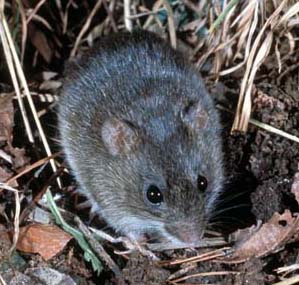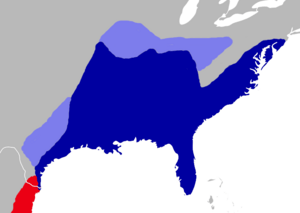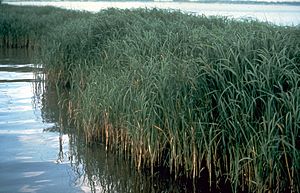Marsh rice rat facts for kids
Quick facts for kids Marsh rice ratTemporal range: Rancholabrean (300,000 years before present) – present
|
|
|---|---|
 |
|
| Conservation status | |
| Scientific classification | |
| Genus: |
Oryzomys
|
| Species: |
palustris
|
 |
|
| Current (blue) and approximate former (light blue) distribution of the marsh rice rat in the eastern United States. A small part of the distribution of Oryzomys couesi is also shown (red). | |
| Synonyms | |
|
|
The marsh rice rat (Oryzomys palustris) is a type of rodent found in North America. It is called "semiaquatic" because it spends a lot of time in the water. You can usually find these rats in wet places like swamps and salt marshes.
They live mostly in the eastern and southern United States. Their range goes from New Jersey and Kansas down to Florida and even a small part of Mexico. Marsh rice rats weigh about 40 to 80 grams (1.4 to 2.8 ounces). They are medium-sized rodents and look a bit like common black or brown rats. Their fur is usually gray-brown on top and lighter underneath. Their feet are special, helping them live in water.
A scientist named John Bachman first found the marsh rice rat in 1816. It was officially described in 1837. There are different types, or "subspecies," of marsh rice rats, especially in Florida. The rats living in the Florida Keys are sometimes seen as a different species, called the silver rice rat.
Marsh rice rats are active at night. They build nests from grass and eat many different things, including plants, fungi, and small animals. They usually live less than a year in the wild. Many animals hunt them, like the barn owl. They can also carry a hantavirus that can affect humans. Luckily, the marsh rice rat is not a species that scientists worry about disappearing.
Contents
What is a Marsh Rice Rat?
Classification of the Marsh Rice Rat
The marsh rice rat belongs to a group of eight species in the genus Oryzomys. This group of animals is found from the eastern United States all the way to northwestern South America.
All Oryzomys species are part of a larger group called Oryzomyini, which includes over 100 different species. These are all in the Cricetidae family, which has hundreds of small rodents. Most of these rodents live in South and Central America. In the United States, the marsh rice rat is the main "rice rat" you'll find.
How the Marsh Rice Rat Got Its Name
The marsh rice rat was first found in 1816 in South Carolina by a scientist named John Bachman. Another scientist, Richard Harlan, officially described it in 1837. He named it Mus palustris. The word palustris is Latin and means "marshy," which describes where these rats usually live.
Later, in 1857, Spencer Fullerton Baird gave the marsh rice rat its current genus name, Oryzomys. This name comes from two Greek words: oryza, meaning "rice," and mys, meaning "mouse." This name was chosen because these rats are known to eat rice.
Other Names for the Marsh Rice Rat
Over time, people have used many different names for the marsh rice rat. Some early names included "rice meadow-mouse" or "rice-field mouse." Later, names like "rice rat" and "swamp rice rat" became common.
Different types of marsh rice rats (subspecies) also had their own names. For example, the "Texas rice rat" for the type found in Texas. Today, it is most commonly known as the "marsh rice rat." The type found in the Florida Keys is called the "silver rice rat."
Appearance and Features
The marsh rice rat is a medium-sized rodent. It looks a lot like the common black and brown rats. However, its fur has a clearer difference in color between its top and bottom parts. Its fur is thick and short.
The top part of the rat is usually gray to grayish-brown. The head is a bit lighter. The bottom part is off-white, and so are its feet. It has small cheek pouches. Its ears are similar in color to its back. There's a small patch of light-colored hair in front of its ears. The tail is dark brown on top and sometimes lighter underneath.
When marsh rice rats swim, air gets trapped in their fur. This helps them float better and keeps them warm. Like many other "rice rats," female marsh rice rats have eight mammae (milk glands).
Special Feet for Water Life
The front feet of the marsh rice rat have four toes, and the back feet have five. The back feet are wide, and their fifth toe is short. They have small webs between their toes, which are helpful for swimming. These features are common for animals that spend time in the water.
Color Variations
The fur color of marsh rice rats can change depending on where they live. Rats from western areas are lighter than those from the east. Florida populations are often more reddish or yellowish. The silver rice rat from the Florida Keys is, as its name suggests, silvery.
Scientists have studied these color differences. They found that there can be a lot of color variation even within the same group of rats.
Size of the Marsh Rice Rat
Marsh rice rats are usually between 22.6 to 30.5 centimeters (8.9 to 12 inches) long from nose to tail tip. Their tail is about 10.8 to 15.6 centimeters (4.3 to 6.1 inches) long. Their hind feet are 2.8 to 3.7 centimeters (1.1 to 1.5 inches) long. They weigh about 40 to 80 grams (1.4 to 2.8 ounces). Males are usually a little bit bigger than females. The largest marsh rice rats are found in Florida and along the Gulf Coast.
Where They Live and Their Home

The marsh rice rat lives in many parts of the eastern and southern United States. You can find them as far north as southern New Jersey, and south to southeastern Texas and a small part of Mexico. They are not found in the Appalachians.
Scientists have found fossils of marsh rice rats from over 300,000 years ago. These fossils show that their range used to be much larger. They once lived further north and west, in places like central Texas and even parts of Nebraska. It's thought that during warmer times, they spread north. When it got colder, some groups might have survived by living near Native American communities that grew corn.
In parts of Texas and Mexico, the marsh rice rat lives in the same areas as a related species, Oryzomys couesi. Even though they live together, they do not breed with each other.
Their Preferred Habitat
Marsh rice rats live in many different places. These include coastal salt marshes, mountain streams, and open areas. They are "semiaquatic," meaning they spend a lot of time in the water. They prefer places with lots of grass and sedges. These plants help protect them from animals that might hunt them.
They can also live in drier areas, especially young rats looking for new homes. These drier spots can also be safe places during high tides. Marsh rice rats are very good at moving over water. Studies show they can easily swim across channels that are 300 meters (1000 feet) wide between islands.
Behavior and Daily Life
Marsh rice rats are active at night, so you usually won't see them during the day. They build their nests from sedge and grass. These nests are about 13 centimeters (5 inches) big. They place their nests under debris, near bushes, in short burrows, or high up in water plants. They might even use old nests built by other birds or muskrats.
Sometimes, marsh rice rats create long paths or dig burrows. They are excellent swimmers and love the water. If they feel scared, they often jump into the water to escape. They can easily swim more than 10 meters (33 feet) underwater.
Marsh rice rats are very clean animals. They groom themselves a lot, which helps keep their fur waterproof. They can be aggressive towards other marsh rice rats and make high-pitched squeaks when they fight.
Who Hunts the Marsh Rice Rat?
Many animals hunt marsh rice rats. The barn owl is one of their most important predators. One study found that 97.5% of the animal remains in barn owl pellets were marsh rice rats!
Other animals that hunt them include:
- Birds like marsh hawks and barred owls.
- Snakes like cottonmouths.
- Alligators.
- Mammals like raccoons, red foxes, minks, weasels, and striped skunks.
Marsh rice rats can also get many different parasites. These include ticks and mites, lice, and fleas on the outside. Inside, they can have nematodes and other tiny organisms.
Health Concerns
Marsh rice rats can get a serious gum disease called Periodontitis. Scientists sometimes study this disease in rice rats to learn more about it in humans.
The marsh rice rat is also the main animal that carries the Bayou virus. This virus can cause a type of hantavirus infection in humans. About 16% of marsh rice rats are infected. The virus is most common in older, heavier males. It can spread among rats through bites during fights. Humans can get the virus if they touch the rats' saliva or urine.
Population and Diet
Population Size and Home Ranges
The number of marsh rice rats in an area is usually less than 10 per hectare (4 per acre). However, in places like the Everglades, if there's a flood, many rats might gather on small islands. This can make their numbers seem very high, sometimes over 200 per hectare (80 per acre).
The size of the area a marsh rice rat uses (its "home range") can vary. For males, it's about 0.37 hectares (0.91 acres), and for females, it's about 0.23 hectares (0.57 acres).
The number of marsh rice rats is usually highest in the summer and goes down in the winter. They also often lose weight during the winter months.
What the Marsh Rice Rat Eats

The marsh rice rat eats both plants and animals. It eats more meat than most other small rodents. What they eat most depends on the season.
Plants they eat include Spartina, Salicornia, and Elymus. They mainly eat seeds and juicy parts of plants. They used to be a big problem for rice farms because they would eat the newly planted rice. They also sometimes eat a type of fungus called Endogone.
Animals that are important to their diet include:
- Insects
- Fiddler crabs
- Snails
- Fish
- Clams
- Young turtles
They also eat dead animals like muskrats and sparrows. They are known to be important predators of eggs and young birds, especially those of the marsh wren and seaside sparrow. They have even been seen eating alligator eggs in Georgia.
In experiments, marsh rice rats were very good at getting energy from their food. They can lose weight if they only eat one type of food, like Spartina or fiddler crabs. But if they eat a mix of foods, they can stay healthy.
Reproduction and Life Cycle
Marsh rice rats mostly breed during the summer. Some studies show that they stop breeding completely in winter, but they can breed in winter as far north as Virginia. This is because the amount of daylight affects their breeding cycle.
The female's estrous cycle (the time when she can get pregnant) lasts about 6 to 9 days. She can get pregnant again soon after having a litter.
Baby Rice Rats
After about 25 days of pregnancy, a female marsh rice rat usually gives birth to three to five young. However, a litter can have anywhere from one to seven babies. A female can have up to six litters in a year.
Newborn marsh rice rats are very small, weighing about 3 to 4 grams (0.10 to 0.15 ounces). They are born blind and almost naked. About half of the babies born are male and half are female.
Here's how baby marsh rice rats develop:
- Day 1: Their ears unfold, and their claws are visible. They make high-pitched squeaks.
- Day 2: They can crawl.
- Days 3-5: Their whiskers and eyelids start to grow.
- Days 8-11: Their eyes open, fur grows, and they start eating solid food.
- Days 11-20: They are weaned (stop drinking milk from their mother).
In the wild, marsh rice rats usually live for less than a year. One study suggested their average lifespan is only seven months.
Marsh Rice Rats and Humans
The marsh rice rat is generally not very important to humans. This might be why scientists haven't studied them as much as some other rodents in North America. Some people find them quite cute, especially compared to the introduced black and brown rats.
Scientists have used marsh rice rats in studies. For example, because they are very likely to get periodontitis (a gum disease), they are used to research this disease in humans.
As mentioned before, the marsh rice rat is the main animal that carries the Bayou virus. This virus can cause a serious illness in humans.
Conservation Status
The IUCN Red List says that the marsh rice rat is of "Least Concern" for conservation. This means it's a common species, found in many places, and its numbers are stable. It also lives in several protected areas.
However, the type of marsh rice rat found in the Florida Keys is rare and its numbers are going down. It is considered endangered. It faces threats from competition with black rats, being hunted by pet cats, losing its habitat, and a lack of genetic variety.
At the northern edge of its range, like in Illinois, the marsh rice rat is listed as threatened. It's not clear if it still lives in Pennsylvania. In Illinois, its population might be growing again because wetlands have been created to protect birds.
Scientists predict that climate change might reduce the marsh rice rat's habitat in Texas in the future.
See also
 In Spanish: Oryzomys palustris para niños
In Spanish: Oryzomys palustris para niños



